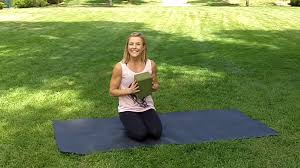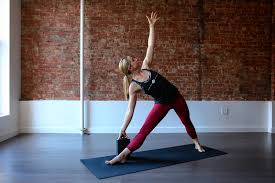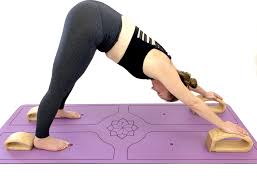Blog
2021-07-02
When you're new to yoga, there are many poses that require only a few basic types of equipment: a yoga mat and a yoga block (also called exercise block). The role of a yoga mat is very intuitive, some kneeling, falling down the action, a yoga mat can protect the joints, but also block the cold ground, strong grip, prevent the movement when slipping. Less obvious is the use of yoga blocks. What can we do with them? How do we use yoga blocks?
Yoga blocks are props or tools that are used to help yoga practitioners in three main ways: to make yoga poses more approachable, to act as support, and to add challenges to develop strength. Yoga blocks are a great tool for building strength all over your body. Many yoga poses are great for increasing strength, but you may not be able to maintain the correct alignment, form, or build up enough strength to enter the pose to reap the benefits. So, suitable yoga blocks can make your body perfectly aligned and keep your muscles in good posture. You can also use them to give you a little extra support in some challenging poses, so you can have better control over the severity of the pose, effectively increasing strength.

If you can't reach the floor in your triangle pose, don't grab your ankles or calves, but use a block. The reason you can't reach the ground is that your hamstrings are tight. The triangle position is a great position to improve your alignment, but it becomes very challenging when you're uncomfortable.
How the block works: You should be completely linear in the triangle, as if you could put it between two walls. When you have trouble keeping your hands on the ground or on your shins, most of the time your body will naturally bend over, destroying proper alignment. When you use a block in a triangle, you give yourself more stability, so you can focus on lifting through your chest, elongating through your fingertips, and folding your front legs.
How to make a triangle with a exercise block:
Starting from Mountain Pose, step out with your feet. Turn your left toe 90 degrees to the left and keep your right toe facing forward.
Place the block next to your left foot, close to your heel.
Lift your arms up above your head, then gently float your left arm down to rest on the block. Lift your chest and extend your right arm up to the sky. Extend through your fingertips, allowing your eye to follow.
Mobilize your core and make sure your body is linear, which means you don't arch or arch your back.
Adjust the height of the block according to your needs so that you align correctly and still feel good about the stretch.

You can't touch the ground with your fingertips for the same reason you can't touch the ground in the triangle: your hamstrings are too tight. When your hamstrings are tight and you're trying to bring your hands to the ground during a standing forward bend, your back will usually curl naturally and you'll miss out on the benefits of this position.
How yoga blocks help: Standing forward bends are a great way to stretch your back and improve hamstring flexibility, but to do this, you need to keep your back straight. Using blocks increases the length and gives better control over the depth of the fold, so you can focus on stretching while keeping your spine aligned correctly, rather than laboriously reaching into your toes.
How to do a standing forward bend with a yoga block:
Starting with Mountain Pose, place two squares in front of your feet.
Place your hands on your hips while keeping your back straight, tighten the core and use it to fold your hips toward the floor.
When you feel your spine begin to curl and start to feel the stretch, place your hands on the block.
Adjust the height and distance of the block to suit you. Placing the blocks further away gives you better control over softer stretches while bringing them closer to your feet provides deeper hamstring and hip stretch.
Downward dog is often referred to as the rest pose in yoga, but if you've ever tried Downward dog as an inflexible beginner, you know it feels like a rest pose. Many people have trouble balancing their weight, so it's not all on their upper body, their wrists are uncomfortable, or they have trouble holding a position because of tight hamstrings.
What Yoga Blocks Do: Elevating your upper body relieves stress on your wrists, balances your weight, and allows you to comfortably dive into postures to improve overall flexibility.
How to do Downward Dog with a Exercise Block:
Start with the desktop location. Grab two blocks and place them under your hand. You can choose to use a wide side or a thin side depending on the height you like, which is better for your hand.
Tuck in your toes and push your hips up and back as you exhale. Use upper body elevation to help you press your heels deeper into the mat.
Remember to still use your core, arms, and legs as if you were in this pose without blocks.

The Camel pose is a good chest opener, but it can be uncomfortable if you have back pain or tight shoulders.
How yoga blocks help: Yoga blocks give you extra length, so you're not forced into backbends that aren't ready. Instead, you'll have more control over how far you go, and can gradually improve as you become more flexible.
How to do the camel pose with a Exercise block:
Start in the hero pose, then lift your seat off your heels and straighten your legs so you can stand on your knees. Your legs can keep about a distance from the inside of your hips without your toes pinching.
Place a block next to your heel. I recommend starting at the highest height.
Start by placing your hands on your hips and lift them up through your chest, then place your fingertips toward your body, one by one, on each block.
Get yourself into a gentle backbend (as comfortable as possible) and let your eyes fall back.
Get out of position by placing one hand back on the hip and then lifting it up to the neutral spine.
Request a Quote
Request a Quote